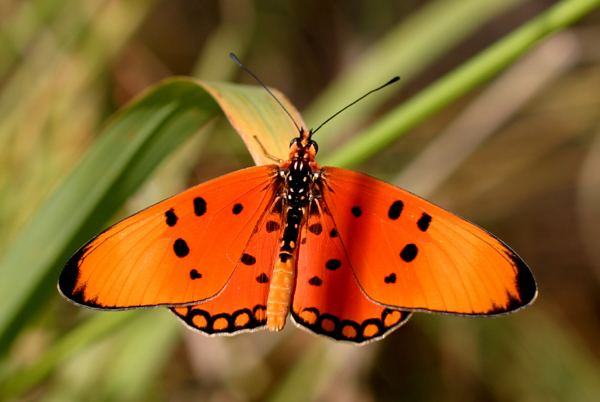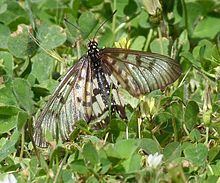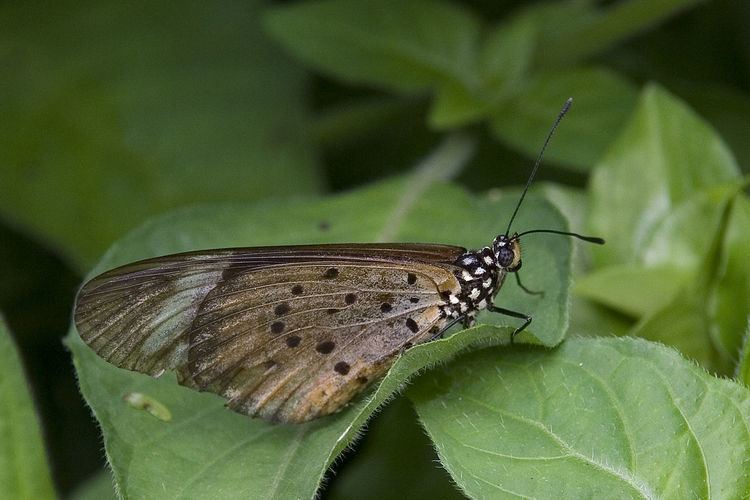Kingdom Animalia Subfamily Heliconiinae Scientific name Acraea Higher classification Acraeini Order Butterflies and moths | Family Nymphalidae Tribe Acraeini Phylum Arthropoda Rank Genus | |
 | ||
Lower classifications Acraea acrita, Acraea horta, Acraea andromacha, Acraea serena, Acraea anemosa | ||
Acraea is a genus of brush-footed butterflies (family Nymphalidae) of the subfamily Heliconiinae. It seems to be highly paraphyletic and has long been used as a "wastebin taxon" to unite about 220 species of anatomically conservative Acraeini. Some phylogenetic studies show that the genus Acraea is monophyletic if Bematistes and Neotropical Actinote are included (see Pierre & Bernaud, 2009). Most species assembled here are restricted to the Afrotropic ecozone, but some are found in India, Southeast Asia, and Australia.
Contents

Biology

The eggs are laid in masses; the larvae are rather short, of almost equal thickness throughout, and possessing branched spines on each segment, young larvae group together on a protecting mass of silk; the pupa is slender, with a long abdomen, rather wide and angulated about the insertion of the wings, and suspended by the tail only. A. horta, A. cabira, and A. terpsicore illustrate typical life histories. The food plants of Acraea caterpillars are usually Urticaceae or, like in most Heliconiinae, Passifloraceae. Some feed on other plants, such as Fabaceae, "Flacourtiaceae", or Violaceae. Their preferred species contain cyanogenic glycosides, which make the larvae and adults poisonous to predators. The aposematic coloration of the adults announces this, and some species are mimicked by less noxious butterflies. At least some "Acraea" are able to produce the toxins themselves. Their flight is slow and flapping.
Systematics and taxonomy

That all these species were properly placed in Acraea has never been generally accepted. In 1807, Johan Christian Fabricius established the genus for the garden acraea, described as Papilio horta by Carl Linnaeus in 1764, and its relatives. By and by, an increasing number of species were placed here. As early as 1848, and again in 1887 and the early 1990s, it was attempted to divide the genus into groups of closest relatives, as it was suspected that some "Acraea" might actually be closer to other genera in the tribe Acraeini.
With increasing availability of DNA sequence data, it is confirmed that Acraea as loosely defined does not constitute a monophyletic group. Even before the attempts to split up Acraea in earnest had begun, Jacob Hübner in 1819 suggested to separate species around Acraea serena as Telchinia. This name has been applied to a generally African group whose members usually feed on Urticaceae, and they had already been noted to bear some uncanny resemblances to the American Actinote in anatomical details. Indeed, they seem to be closer relatives of these than of the other butterflies placed in Acraea, which usually feed on Passifloraceae and are at least in part quite close relatives of the African genus Bematistes. Those closest to that genus might warrant separation as Rubraea or Stephenia.

But while several informal species groups have been established, it is not clear which of these are monophyletic and how to split the apparently still paraphyletic genus further. The placement of the garden acraea—the type species—and hence which of the any further subdivisions will get to bear the name Acraea, remains unresolved. As it is traditionally included in the former A. terpsicore group (now A. serena group) and its caterpillars, while polyphagous, do not feed on Urticaceae, it may be that the separation of Telchinia is unwarranted and other proposed genera might be resurrected instead.
There was one major misidentification which still causes confusion today. Acraea terpsicore, described as Papilio terpsicore by Linnaeus in 1758, was held to be the senior synonym of A. serena, described by Fabricius as Papilio serena in 1775. Hence, the former name was commonly used for that African species. But as it turned out, Linnaeus had actually described an Indian species—the well-known tawny coaster. Fabricius in 1793 believed it was new to science and described it again, as Papilio violae. Consequently it had been long known as A. violae. It was also recognized that Fabricius' little-studied P. serena was none other than the orange acraea. For this, the name A. eponina, from the Papilio eponina established in the 1780 issue of Pieter Cramer's De uitlandsche Kapellen, had been used all the time. Another instance of the confusion rife in this genus is exemplified by Boisduval's Acraea manjaca.
These developments come from the two papers which has been written by J. Pierre and D. Bernaud. You will find these papers here: http://acraea.com/image/liste/Acraea_terpsicore.pdf and http://acraea.com/image/pdf/serena_01.pdf
Species
Since the proposed phylogenetic sequence of the species groups is almost certainly incorrect for a large part, the groups are simply listed alphabetically.
But J. Pierre & D. Bernaud have published recently a complete systematic and synonymic list. You will find it here: http://acraea.com/image/liste/systematique.pdf
Acraea acrita species group
Acraea andromacha species group (close to part of A. terpsicore group?)
Acraea anemosa species group
Acraea aureola species group
Acraea bonasia species group (close to A. oberthuri and A. rahira groups? Paraphyletic?)
Acraea caecilia species group (close to A. cepheus and A. egina groups?)
Acraea cepheus species group (close to A. caecilia and A. egina groups?)
Acraea circeis species group (close to A. masamba)
Acraea egina species group (close to A. caecilia and A. cepheus groups?)
Acraea encedon species group (close to A. jodutta and A. pharsalus groups?) – common acraea or white-barred acraea or encedon acraea
Acraea issoria species group (a rather distinct lineage?)
Acraea jodutta species group (close to A. encedon and A. pharsalus groups?)
Acraea masamba species group (close to A. circeis?)
Acraea oberthuri species group (close to A. bonasia group?)
Acraea pentapolis species group (close to A. circeis and A. masamba groups?)
Acraea pharsalus species group (close to A. encedon and A. jodhutta groups?)
Acraea rahira species group (close to A. bonasia group?)
Acraea satis species group
A. terpsicore group
Acraea terpsicore species group (formerly A. violae group)
Acraea zetes species group (might include part of A. serena group; a very distinct lineage?)
Species group undetermined
Some other species formerly in Acraea have now been definitely assigned to other genera, e.g. Bematistes.
